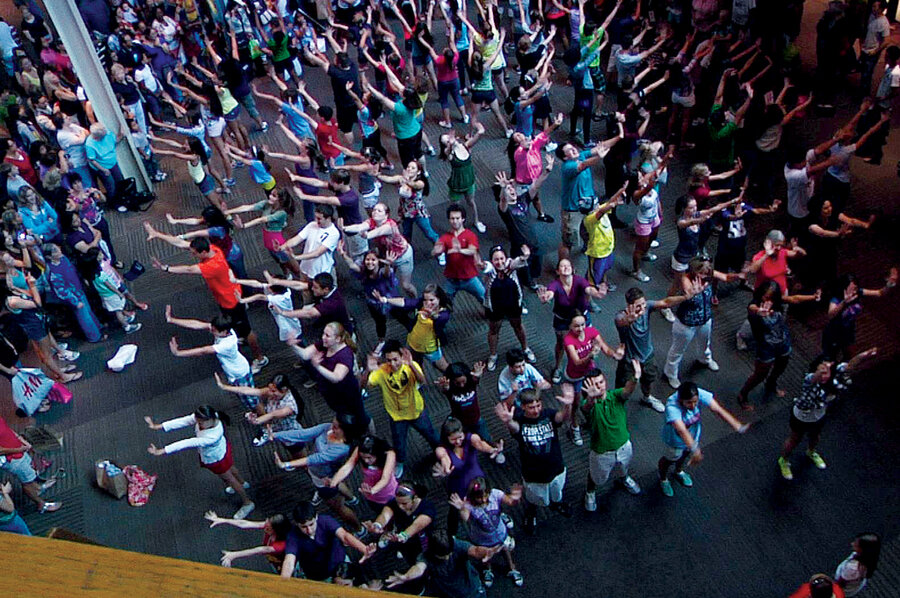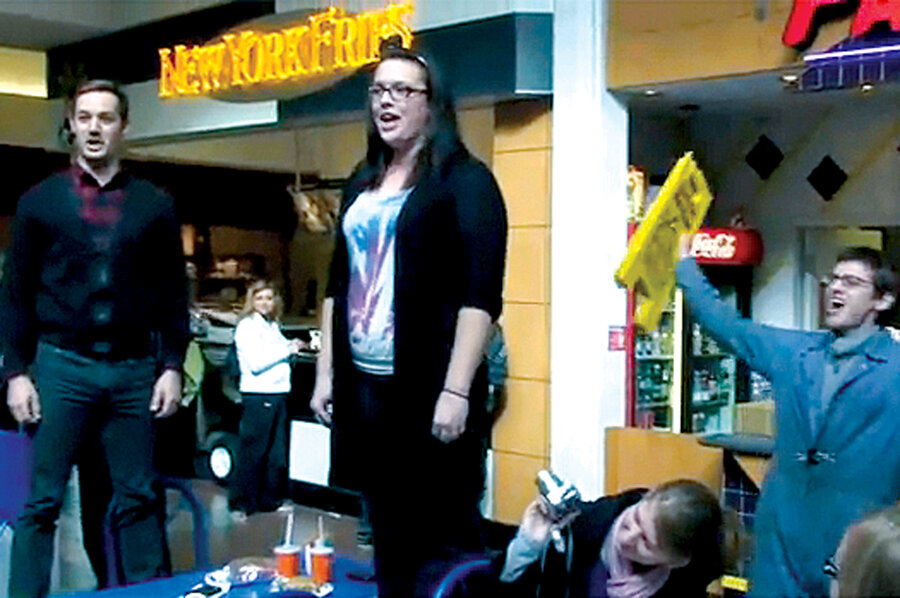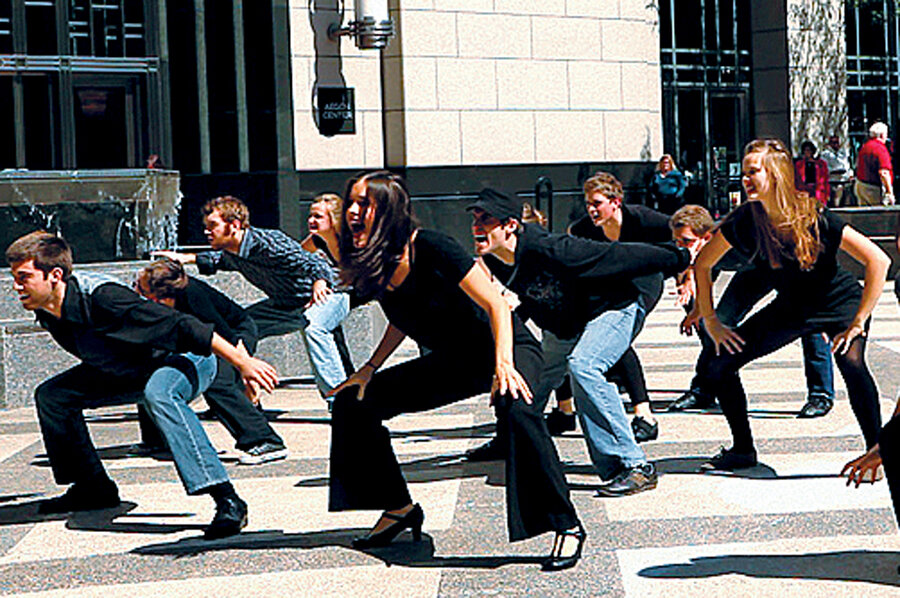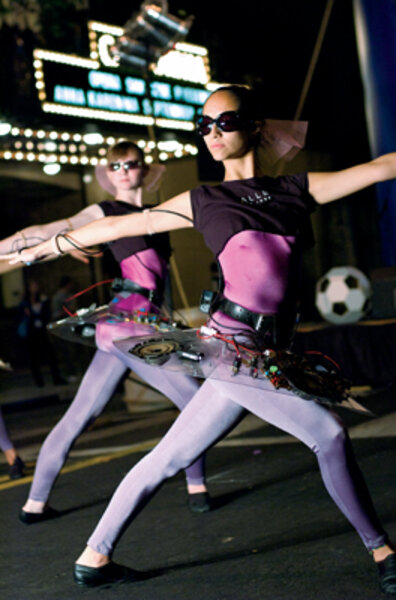Art Attack! Random acts of culture
Loading...
Flash mob, art mob, flash crowd, public intervention, or just random acts of culture. Whatever the name, these spontaneous gatherings – facilitated by Facebook, Twitter, and YouTube – are hot among the mobile, hyperconnected, and commitment-averse social-media generation.
And they are now the latest darling of more traditional cultural institutions who are working to remain relevant in the new media environment. Opera companies, dance troupes, and theater ensembles are all looking for ways to get out of traditional spaces – and into the larger public's face.
Whether it's a spontaneous rendition of Handel's Hallelujah chorus amid a busy shopping day at Macy's, or thousands of dancers simultaneously executing the same choreography in multiple far-flung cities,or a clutch of actors suddenly morphing into vampires in the middle of a hungry lunchtime crowd – all caught on video and posted online – artists are trying to break old habits and startle, surprise, and seduce new audiences.
As these artists try to see themselves in new ways, they also hope these unexpected encounters will allow audiences to see them with new eyes.
Art institutions across the board are trying to shed what Opera America president Marc Scorca calls "an edifice complex." Partly fueled by declining audiences, he says, but also responding to a deeper need to reclaim the kind of central cultural relevance that such venerable institutions as the ballet and the opera once had in a community, these groups are struggling to break free of traditions that make them seem either outdated or nonvital.
This impulse fits a larger cultural current. "The old elite cultural divides are breaking down," says Clarke Mackey, author of "Random Acts of Culture: Reclaiming Art and Community in the 21st Century," a work detailing the rise of participatory culture over so-called "expert culture" – largely "fueled by the power of Web 2.0," he says.
Young people weaned on the new technological tools that let them create a feature film for a few thousand dollars or score a symphony with a few clicks of a mouse have little appetite for the sort of passive spectator behavior demanded in hushed recital halls or remote downtown opera houses.
"They want the sense of newness and immediacy and engagement in cultural experiences that they have in the rest of their life on Facebook and Twitter and their cellphones," says Mr. Mackey.
More than once over the past nine months, shoppers at the Orlando Fashion Square mall in Florida have had their routine enlivened by the sudden appearance of dancers pirouetting and swinging past shops and across busy food courts. Organized through e-mails by the local chapter of USA Dance, the most recent event in November featured dozens of couples descending on the mall and launching into choreographed steps.
"The goal is just to show people how much fun dance can really be," says chapter president John Davis. He caught the flash-mob bug, he says, from an online video showing a crush of dancers executing a Viennese waltz in a train station.
Teams of thespians are spreading the same message about theater. The Actors Theatre of Louisville in Kentucky arranged for actors to morph into blood-sucking fiends at a popular lunch spot. New Jersey's Paper Mill Playhouse deployed 130 dancers from the musical "Hairspray" at two locations.
"All the art forms beyond TV and movies are struggling," says Paper Mill Playhouse's Shayne Miller, who says the goal is to move community members to see the theater as part of their lives, not off in a remote building.
From a marketing standpoint, this is an update on an old axiom. "The goal is to get potential consumers to take a second look at something that frankly, many have not even taken a first look at," says author Mark Stevens ("Your Marketing Sucks."). He notes with some exasperation that "99 percent of those who say they don't like ballet have never even gone to a ballet." Yet over and over, he says, large legacy cultural institutions are met with this dismissive attitude from younger audiences.
The burden, it seems, is on the cultural group to redefine the relationship. If we can't draw this cohort into the conventional four-wall theater space, then "we have to bring it to them," says Teresa Eyring of Theater Communications Group, a nonprofit theater-advocacy organization in New York.
In the process, the institutions that treat the outreach as more than a mere marketing ploy evolve themselves, says Alex Riley, a professor at Bucknell University in Lewisburg, Pa. As cultural groups work to understand their communities, he says, "when the audiences give them that second look, they will no longer be what they were when they were not getting that first look."
What is less clear is whether this purposeful serendipity leads to the kinds of financial support that large institutions require. Data on the bottom-line effectiveness of such strategies are scarce in these early stages, Ms. Eyring says. But "anecdotally, we are seeing that more awareness leads to more participation in some form down the road." However, she adds, the real goal of this self-examination and experimentation is not strictly financial. It is about exploring what it means to be an artist and the value and place of art in a community.
The tension between stretching artistic muscles and marketing a product is one that bedevils most cultural institutions, Mackey says. Marketers tend to co-opt anything that appeals to a large demographic, especially a younger one. Witness the YouTube video "T-Mobile Dance," in which a choreographed dance (with music) erupts at London's Liverpool Street Station: The object is to hawk cellphones. "Our culture is ready to bottom-sell anything that works," he says.
Parsing the difference ultimately matters, says Villanova University's Gordon Coonfield, because "the artist's vision pulls us forward while the marketer's generally shackles us."
But there is already organized support for flash/art-mobbing as an art form of its own. In November, Knight Foundation launched a three-year, eight-city grant project dubbed "1,000 Random Acts of Culture" designed to fund flash events in support of classical arts – beginning with the Opera Company of Philadelphia's Handel chorus at Macy's.
Over in California's Silicon Valley, the nonprofit art and technology network ZERO1 commissions new art. Spontaneous "art mobs" are an important tool in that process, because they allow the artists and the public to create a new work together, says social-media manager Danielle Siembieda.
Organized spontaneity may seem an oxymoron, but success breeds commodification if nothing else in a consumer culture. And so, Flashmob America, a Los Angeles firm barely a year old, now offers professional flash-mob services – for your ballet troupe, wedding, trade show – or simply your pleasure, if you can afford their services.
The firm organized a flash mob for ABC's "Modern Family" on a recent episode and will be profiled on an upcoming series on Style network in January called "Kimora: Life in the Fab Lane." The partners behind the company say they have run flash mobs for everything from the L.A. debut of the Broadway musical "In the Heights" to a Haiti benefit and a Janet Jackson event.
But in the end, even though it would seem the ultimate co-opting of a form of expression designed to fly free, co-founder Staci Lawrence explains that this is, in fact, the art form of this generation – "a way for all kinds of people to experience surprise and joy."
In a world increasingly defined by niche interests and personalization, says sociologist BJ Gallagher, "it becomes more important than ever to find ways to encounter things that actually surprise us."
After all, adds Ms. Lawrence, isn't that the purpose of art?










